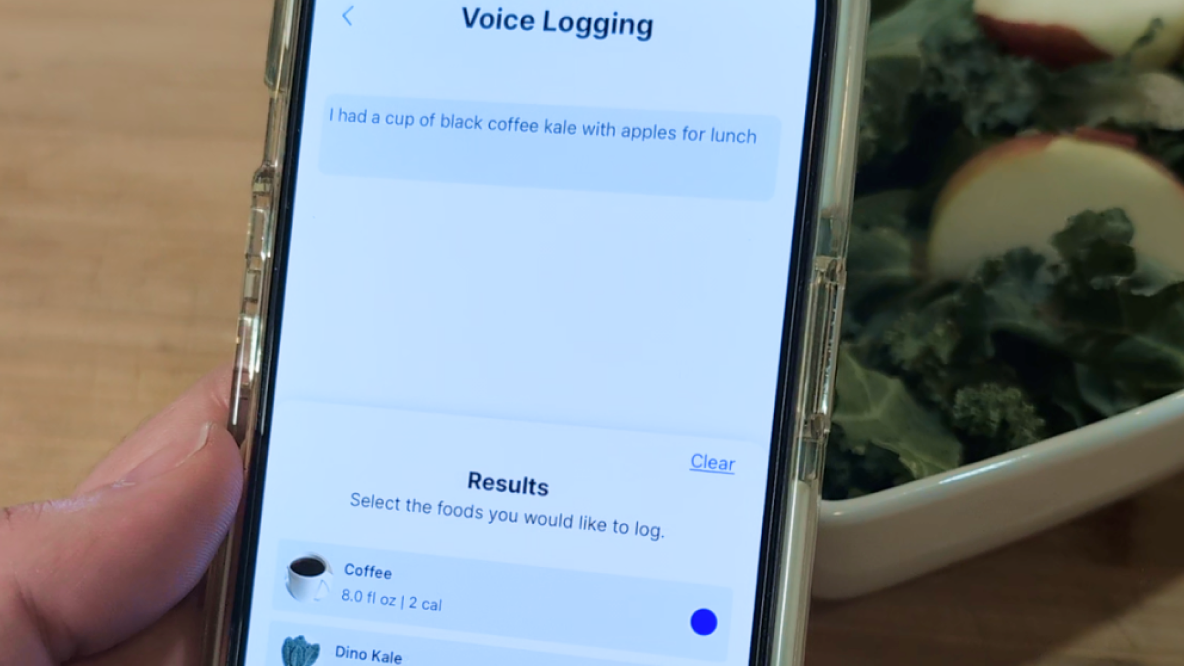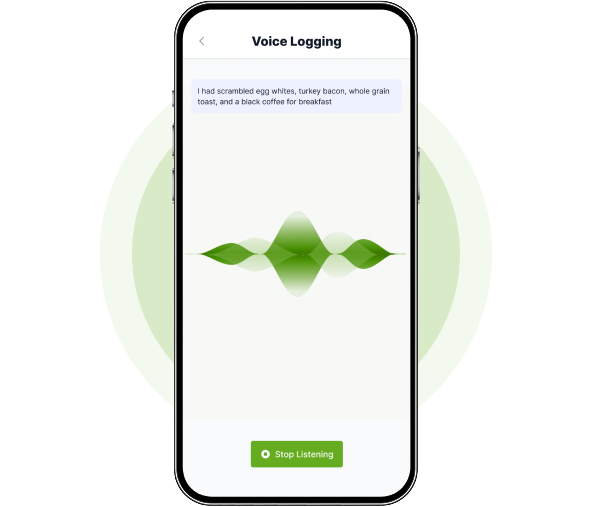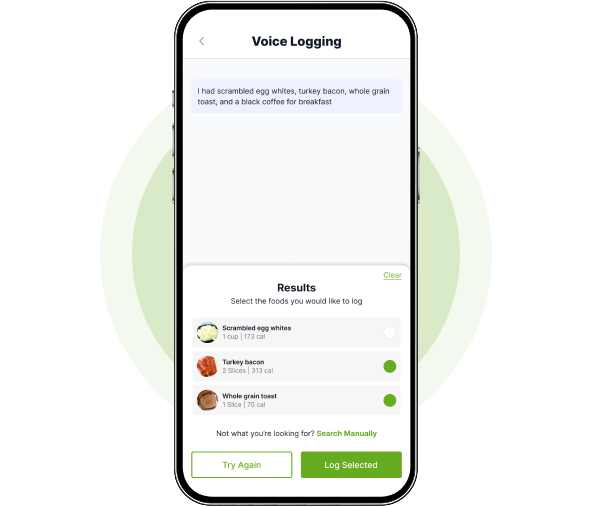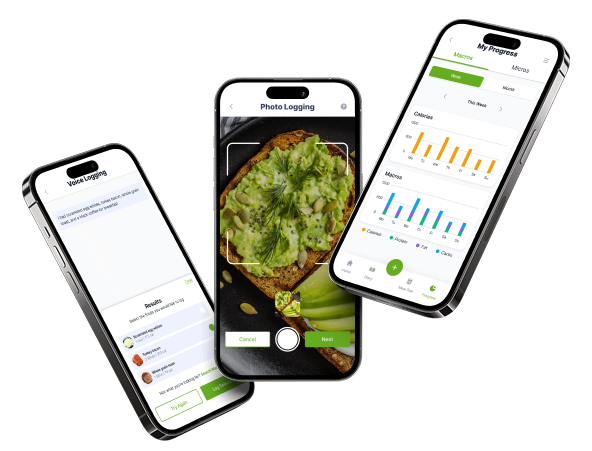Speak naturally. The Nutrition-AI SDK transcribes your meal and breaks it down into loggable food items instantly.

Feature Highlights
Just say what you ate and the AI understands full meals and recipes.
Breaks down a sentence into structured, loggable items with quantity and calories.
Ideal for driving, walking, or multitasking just tap the mic and talk.

Users can say full sentences like “I had scrambled egg whites, bacon, and whole-grain toast.”
No need to pause, format, or break up your thoughts, the AI handles it.
Works in any language supported by your mobile OS speech engine.
The voice transcript is automatically parsed into separate foods.
Each item includes quantity, serving size, and calories when available.
Easily select and unselect any item before logging.


See how Nutrition-AI Hub’s SDK and APIs can can transform your app in just a few clicks.
Find answers to common questions about Nutrition-AI Hub, including pricing & usage tips.
Our standard setup does not store data that can identify the user in any way. Consumers of our SDK might store that data, but Passio does not. The SDK might cache the license key for faster authentication, everything else is just used for the nutritional data.
We do not store this data, but the data is transitioned to our LLM that could be a third party LLM such as GPT. As a technology provider we rely on and require our customers to ensure no personal data is transferred to Passio.
Passio Hub takes data security seriously. Data processed via the cloud-side recognition is handled with strict security measures to ensure privacy and protection. On-device recognition keeps the data local to the device, providing an additional layer of security by not transmitting photos to the cloud.
There are no strict limits to the number of users you can have. However, your token usage will increase with the number of users, so you should select a subscription plan that accommodates your user base and expected usage.
Currently, we do not offer free trials. Upon purchasing, you will be billed immediately for the token credits. This pricing model ensures we can cover the necessary costs required to serve your needs and maintain the high-quality service you expect.
To estimate your monthly cost, use the "Calculate Usage & Pricing" tool on the pricing page. Adjust the sliders for the number of users and various types of requests to see an estimate of your token usage. The tool will then provide a recommended plan and estimate the total monthly cost, including any overage charges if applicable.
The Mobile SDK Quick-Start App is a demo provided by Passio that gives you a reference on how you could integrate our SDKs and REST API into your mobile application quickly and efficiently. It includes sample integrations and reference implementations to help developers understand setup and best practices.
Our billing portal allows you to configure an automatic refill option, should you exceed the monthly token limit included in your plan. By default, this setting is enabled on your account. When enabled, if you make a request to the API and dont have enough tokens, you will automatically be billed at a rate of $2.50 per million tokens to top up the number of tokens you have set.
For example, if your refill amount is set to 2 million tokens, you will be charged $5.00 and gain 2 million more tokens.
There are no volume discounts on refills, but you can manually purchase additional tokens at any time through the dashboard. If the automatic refill option is turned off and you run out of tokens, the service will stop responding until more tokens are added.
Volume discounts are applied based on the number of tokens you use. The rate per million tokens decreases as your usage increases, as follows:
These discounts can significantly reduce your monthly cost if you have high token usage. Volume discounts are not applied on refills.
The REST API is essential for the mobile SDK to gather all necessary food information and is required for the SDK to function. The API offers a wide range of capabilities, including:
This comprehensive access ensures that you can fully leverage the capabilities of our food database and Nutrition Advisor in your applications.
Yes, you can upgrade or downgrade your subscription plan at any time to better suit your usage needs. This flexibility allows you to adjust your plan based on changes in your application's user base or feature set.
To calculate the number of tokens needed for your application, you can use the "Calculate Usage & Pricing" tool on the pricing page. By adjusting the sliders for the number of users, API requests, Vision AI requests, and Text AI requests, you can estimate your total token usage and corresponding costs.
If you exceed the monthly token limit included in your plan, our billing portal allows you to configure an automatic refill option. By default, this setting is enabled on your account. When enabled, if you make a request to the API and dont have enough tokens, you will automatically be billed at a rate of $2.50 per million tokens to top up the number of tokens you have set.
For example, if your refill amount is set to 2 million tokens, you will be charged $5.00 and gain 2 million more tokens.
There are no volume discounts on refills, but you can manually purchase additional tokens at any time through the dashboard. If the automatic refill option is turned off and you run out of tokens, the service will stop responding until more tokens are added.
Our token pricing is designed to be simple and predictable. We roll the input and output token costs into a single average value. This consolidated price also covers additional costs, such as Passio API usage, ensuring a consistent billing platform. This approach allows us to update and improve our AI models without needing to change our pricing structure.
A token is a unit of measurement used in AI processing to represent pieces of input or output data. For example, when you send text to an AI, the words and punctuation are broken down into tokens, which the AI then processes.
Tokens are used to quantify the usage of Passio services. Each action, such as an API request, Vision AI request, Text AI request, or Chat Message request, consumes a specific number of tokens. The monthly plans include a set number of tokens, and users can purchase additional tokens if they exceed their monthly limit.
Costs per user will vary depending on usage. You can use the calculator provided on Passio's account portal to estimate token usage.
For example, if a user sends one photo to the API for analysis, it will result in 5k tokens spent from the account. So while costs can vary, we estimate that an average user logging meals regularly for one month would utilize around 250k tokens.
To manage costs, you can limit usage to a fixed amount by engineering your app with token limits. For instance, you could limit a free user to 80k - 100k tokens and then ask users to pay once they reach that limit. This approach allows you to demonstrate value to users while keeping your cost between 1 to 10 cents per user.